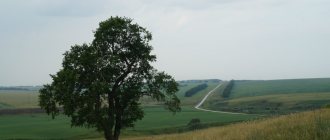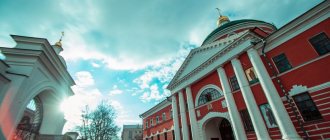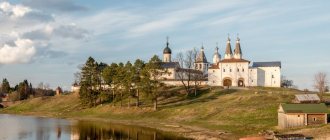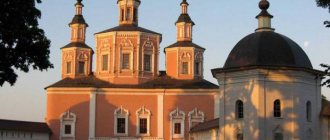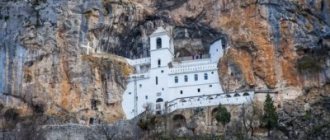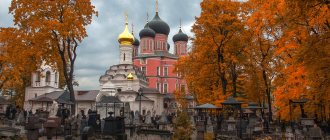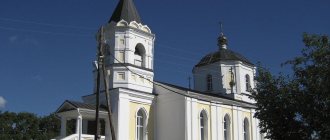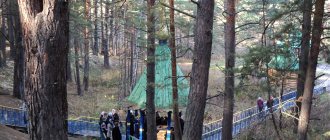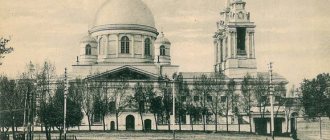Oran Monastery: historical milestones
There are many written sources covering the history of the creation of the monastery near the Field of Oran on Slavenovo (today Slovenian) Mountain. The first of them is a handwritten Tale of the emergence of the monastery, set forth by an unnamed monk author in 1662.
Where did it come from and how did it begin?
The hills on which deserts were founded at the beginning of the second third of the 17th century (as territories inhabited by hermits were traditionally called) were surrounded by impenetrable Trans-Volga forests for centuries. In order to prepare it for development, the forest area had to be cleared, and the exposed Oran-field (the toponym goes back to the Old Slavonic orati) had to be plowed up. Hence the word Oranki - “plowed place”. Long before the Slavs moved here, however, the pagan Mordovians considered this area theirs.
How could an Orthodox hearth arise on a site used for centuries by pagans as places of prayer and bloody sacrifices to numerous deities of savage tribes?
Thanks to the Nizhny Novgorod patrimonial owner of noble blood, Pyotr Andreevich Glyadkov (according to other sources - Gladkov/Glyatkov). Having risen to the rank of military head and having resigned, he decided to retire from the world and settled in the village of Bocheevo - his patrimony.
He saw the meaning of further existence in rational management, raising his sons and admiration of the Vladimir Icon of the Mother of God of the Dormition at the Moscow Cathedral. The former warrior felt the power of the image of the Mother of God personally: the Most Pure One healed him of a serious illness.
5 years later, in gratitude, in 1634, P.A. Glyadkov ordered a copy (that is, a copy) of the miraculous icon to the painter Grigory Cherny. The founding of the monastery was subsequently dated to this year. The very idea of building a temple on a nearby hillock came to Glyadkov after three identical prophetic dreams, where a voice from above commanded the sleeper to build a church in honor of the patroness icon in a place pleasing to the Mother of God. And before that, erect a cross on God’s chosen mountain.
The owner of the estate did not know the exact location of the sanctuary, but soon, crossing the Oran field, he saw a fiery radiance shooting upward from the bowels of the earth. Taking this as a sign, the associate understood: Oran Mountain was chosen to realize the idea expressed in dreams.
All that remains is to receive the patriarch's blessing for the construction - and begin to implement the wishes sent from heaven. Glyadkov installed the marble cross-symbol in 1634, thereby marking the foundation of the future temple.
The first-born wooden church was built in a matter of time - in three months. The opening took place in 1634 (according to some sources - in 1635), on September 21 (October 4 according to the new calendar), on the day of the Apostle Kondrat, memorable for believers. The copy icon was brought to the altar in the hope that it would repeat the miraculous effect of the original. A log cell was built around the church, and eight elders moved in under the leadership of Hieromonk Theodoret.
Hopes for the bright aura of the image of the Mother of God were justified: almost from the first days, the miracle icon began to stream myrrh, healing dozens of pilgrims. The blind regained their sight, the demoniac became kinder, the mute gained hearing, and those stricken with ailments of their arms and legs regained mobility.
Miracles were recorded officially, in every detail. The fame of them spread throughout the country, reaching the ears of the patriarchs and sovereigns. In the first decade, the list of happy cures exceeded 5 hundred.
Along the path of achievements and troubles
The fate of the founder of the Oran desert temple was tragic. Having taken monastic vows under the name Paul 8 years after the consecration of his brainchild, he moved into its walls and took over the management of the community of novices. With this, a new, already monastic period began. It was accompanied by dissatisfaction with pagan neighbors, who obstructed the cutting of trees, picking berries and mushrooms, and launched attacks on the building itself. These protests ended with the murder of the founding schema-monk in 1665.
This event put an end to the hostile attitude of the Mordovian environment - the opponents stopped attacking, and their descendants eventually became interested in Christian values. After the death of its creator, the Oransky Bogoroditsky Monastery more than once supported morally and physically the residents of the Nizhny Novgorod province and surrounding lands. In 1771 The power of the protective icon was confirmed in practice: after the Vladimir-Oranskaya icon surrounded the Kremlin walls, the city was left by an epidemic of pestilence (plague).
The residents of Nizhny Novgorod celebrated the retreat of the terrible scourge with a prayer procession - and from that moment on, processions of the cross began to be held systematically. Stories about the miraculous abilities of the healing icon aroused extraordinary interest among flocks near and far. People flocked to the monastery and left offerings as a sign of gratitude for the miracle healing. Incomes were growing. Not only the heirs of the Glyadkov family, but also representatives of other noble families wanted to continue the holy undertaking.
Support was manifested in gifts intended to decorate the interior of the buildings, and in the flow of valuable religious literature. Precious utensils and books were given by the princes Odoevsky, Cherkasy and Gorchakov, merchants Stroganov, boyars Buturlin and even Georgian princesses. There was a need for restructuring, internal and external. The 20s of the 18th century were marked by this. The wooden church was replaced with a stone one, and a bell tower and stone cells were erected next door. The old Chernetsky chambers were strengthened, and the courtyard began to be surrounded by a strong fence.
The result turned out to be unpredictable: the once rich treasury was depleted and the church economy fell into decay due to unaffordable costs. In addition to the abode of the schema-monks, Peter the Great assigned the completely impoverished Holy Cross Hermitage of the Exaltation with its 26 monks. The patron monastery was not able to support them all - only nine Chernets were able to resettle. In 1771 The half-empty building of the Cross-Mar Brotherhood was finally plundered by the Pugachev rebels.
The period of survival has begun. The bookshelves were thinning, icons and decorations were being pawned. The proceeds went to bread. Catherine II deprived the monastery of all estates, serfs, and land plots. The monastery was excluded from the list of staff members, and government funds stopped flowing to the needs of the inhabitants. Only 19 people remained from the former brethren; they looked for food themselves. The turning point was the chain of events described somewhat above - plague-pestilence-deliverance-processions.
This ended a series of material disasters. The stage of organized pilgrimages of pilgrims to the glory of the Patron Mother of God and with the aim of further strengthening and exalting the cathedral complex began.
Processions of the cross, design, construction and arrangement of the monastery before the revolution
Construction plans resumed at the beginning of the 19th century. The stimulating factor was the crowded crucifixions - not just annual ones, but autumn-winter and spring ones. They were often called Mordovians, which confirmed the spread of Orthodoxy among peoples who had previously denied Christian concepts and faith. The Vladimir-Oranskaya icon managed to visit a hundred or more populated areas over the course of a year. There was no longer any question of money for construction: it went on continuously.
In 1804-1819 The spiers of the beautiful cathedral of the Vladimir Icon of the Mother of God pierced the vault of heaven. After less than 30 years (in 1837), a three-aisle Church of the Nativity of the Virgin Mary with five domes and a single-throne church of Peter and Paul were built. There grew five stone buildings accompanying the main one, a chapel over a healing spring and a horse yard. In 1867 The Oransko-Bogoroditsky monastery complex was elevated to the rank of first-class. The bishop began to manage it.
In 1905 a forest monastic monastery appears, and next to it - another stone church under the name of the Dormition of the Mother of God. The religious processions continued, leading outside the Old Believer villages. The icon-healer was often carried in their arms for 50 miles and was allowed to be brought into houses during breaks between services - out of a desire to help the seriously ill and immobile. She was repeatedly involved in the blessing of church and temple institutions under construction.
In 1913, the shrine, together with the people of Nizhny Novgorod, greeted the Tsar, congratulating him on the 300th anniversary of the Romanov Dynasty. At the turn of the 19th and 20th centuries, the Oran monastery flourished. In addition to the leading ensembles, 6 fraternal dormitories were already rising under its shadow. A hotel for pilgrims, a brick water pump for an extensive water supply system, a bathhouse and a dozen shops, cellars and barns were pleasing to the eye. There was an apiary, a pharmacy, a garden with a vegetable garden and a stable, too.
The yard was also equipped with workshops - carpentry, metalworking, tailoring and shoemaking. There was also a brick factory with a forge. Any restoration or everyday problems were solved on our own; everything necessary was done on site. Not only monks worked here; there were also plenty of tasks for artisans from nearby villages. The opportunity to read and become spiritually enlightened was also preserved - for this there was a library and a museum of church values.
The twentieth century and its consequences
The year 1917 interrupted the bright ascent of the Orange cenobitic monastic community to the highest point of its development and prosperity. The October Revolution had a negative impact on the fate of the entire Russian Orthodox Church, and the Mother of God Monastery as its largest link. On the eve of the twenties, religious educational institutions were liquidated, monasteries were closed, religious and social institutions and ruling spiritual organizations were destroyed.
Already in July 1918, Archimandrite Augustine, appointed rector less than a year before the conscription speeches and palace assaults, was arrested and accused of counter-revolutionary plans. The Holy Father was shot almost immediately after his arrest, and in August another 15 of his associates were shot. Their death was the impetus for a series of sad events. The number of Oran monks quickly decreased fourfold - from 200 to fifty. The monastic lands were nationalized, and by 1928 there were only 17 inhabitants left.
But the procession of the cross with the face of Our Lady of Orange did not stop. Despite the actual closure of the monastery and all sorts of prohibitions, believers came to Oranki to see the shrine and pray and be healed at the source. Until 1954, regular prayer services, albeit with a relatively modest crowd of people, continued. In close proximity to a long-defunct monastery (it was officially closed by the authorities in 1920).
A monastery with a “Comintern” face
In what guises was the monastery-dormitory quarter “cleansed” of monastics not used! Theater rehearsals took place in the warm church; a nursing home and a vocational school for carpenters and garment workers moved to other premises. The network knitting factory successfully coexisted with the People's University. A little later, colonies were placed here - for minors, and then for adult criminals. In the summer, street children rested here. The chronology of changes was completed by a medical and labor dispensary.
The most significant traces were left by the camps of the 40s. At first they brought Finns into them, followed by interned Czechs and Poles. Subsequently, the composition was supplemented by German and Romanian prisoners of war. There were also plenty of Italians, French, Hungarians and other representatives of European nations. The German sector was dominated by high-ranking officers - after Stalingrad, even Field Marshal Paulus flashed among them.
The prisoners were not forced to do hard work; on the contrary, they tried to re-educate them, instilling in them communist views in an anti-fascist school sponsored by the Comintern. Secretaries of the Communist Parties of Germany, Hungary, and Romania gave lectures at the courses. It was planned to organize international brigades, but this dream was not brought to its logical conclusion. And here is a cross and a memorial of four monuments that immortalized the names of refugees and occupiers buried in the general camp cemetery, at the request of their children and grandchildren in 1995. opened.
Orthodox Sarov
On July 5-6, 26 Sarov residents took part in the traditional religious procession from the village of Epiphany, Bogorodsky district, to the Oransky Monastery in honor of the Vladimir Icon of the Mother of God.
Orange icons and human destinies
At 4 o'clock in the morning we left Sarov on two gazelles. We caught up with the religious procession already halfway to the village of Armanikha and joined it. In addition to Armanikha, we made stops in the village of Siukha (the church there was destroyed), in the forest and in the village of Shonikha. About 80 people were constantly walking. There were pilgrims from Nizhny Novgorod, Arzamas, Kstov, and other cities and villages. According to the participants of the procession, in the 1990s. there were ten times more people.
The procession was headed by Father Vladimir from Epiphany, and the main shrine of the procession was the Vladimir-Oranskaya Icon of the Mother of God from this village. Over the course of two days, we came across several copies of the Oran icon. The church in the village of Armanikha has its own Oran icon, when approaching the monastery we were greeted and overshadowed by another. In the monastery itself there are also two Oran icons of the Mother of God - a copy and an original, both miraculous.
At the religious procession, people communicated, made acquaintances and rejoiced at meeting old acquaintances. They talked about healings and cases of God’s miraculous help in their lives, confirming that God is not far from each of us. Some women, even during halts, did not indulge themselves, reading the akathist on their knees in front of the Oran Icon of the Mother of God. Others could not resist and tore strawberries, which were surrounded by the sea. In Siukha and Shonikha, hospitable residents fed the pilgrims a sumptuous meal. Some owners placed cold water and berries along the procession route.
In Shonikha we were treated to pious people who had moved to the village from Moscow. They live on pensions and subsistence farming - they keep cattle and garden. The grandchildren graduated from primary school in Oranki and now the problem arose of where they should study next. The family is spiritually nourished in the monastery. They anxiously follow events in the country and the world, vigilantly looking out for signs of recent times. “Do you have a dacha, a vegetable garden?” - they asked me. "No? Then you will dig dugouts and escape there,” the hostess said confidently.
Nizhny Novgorod resident Elena has been going to this religious procession since childhood. She told a family legend associated with the Oran Icon of the Mother of God. When she was a baby, in 1989-1990, she lived in a dacha in Schonich. Then her mother saw a religious procession for the first time in her life and was confused, not realizing to dive under the miraculous icon. But the religious procession went in the wrong direction and was forced to return. The old women claimed that this was the first time such a failure had occurred. Mother and daughter kissed the icon. Since then, my mother began to grow in faith, and the Oran monastery is a particularly revered place for this family.
It must be said that in those years the procession could not get inside the monastery; it only went to the source of the Mother of God. Until 1993, the monastery complex housed a women's correctional colony. Before that, from 1971 to 1985. – male prison camp, even earlier – a colony for teenagers. During the war and until 1950 there was a camp for German prisoners of war, and in 1939-1941. – where interned employees of foreign embassies lived. The monastery was returned to the Church in a deplorable state, but before the revolution it flourished, there were 200 inhabitants...
In the monastery
In the monastery, the religious procession was greeted with the ringing of bells. All the pilgrims rushed under the large bell, dozens of hands reached out to it. A sound wave pierced the body through the hand, and tears flowed from the eyes. They washed away the apathy of fatigue, stirred up the soul, arousing endless gratitude to God and His Most Pure Mother, who brought us to this corner of heaven on earth.
I was in the Oran monastery about 15 years ago. Of course, over the years it has changed beyond recognition. The huge bell tower, destroyed during Soviet times, is being rebuilt. Extensions were dismantled, disfiguring temples. All monastery buildings are painted in dazzling white and blue colors - the shades of the temples of Southern Greece.
By the outer metal staircase I recognized the building in which we had once spent the night on the floor, on mattresses. It turned out that this was a monastery refectory with a house church in the name of Peter and Paul. Now pilgrims are housed in a three-story building outside the monastery (former zone headquarters). There are bunk beds, clean linen, delicious food. At first I thought that local residents worked in the monastery. But it turned out that, for example, the women who fed us came specially from Moscow for the monastery’s holiday to help cope with the influx of pilgrims.
Near the monastery there is a well-maintained spring and an indoor bathhouse with two sections: men's and women's. Swimming in the cold water took away the fatigue, and we stood through the entire service, after which there was confession.
In the building of the monastery shop, the children looked at the parrots, and the adults looked at the large assortment of literature and CDs, incl. own products (recordings of sermons by the abbot of the monastery, Archimandrite Nektary (Marchenko).
There are stands in the shop that show the stages of restoration of the monastery. The photographs show how badly the paintings in the temples were damaged; their new inhabitants amused themselves by shooting at the faces of the saints. Now the interior paintings in the Vladimir Cathedral have been restored. There is also a wonderful five-tiered tiled iconostasis in four colors: white, gold, light blue and dark blue. The icon cases of two large icons are made in the same technique: the Vladimir Icon of the Mother of God with the Standing Ones and the Holy Trinity. We touched it - it really is ceramics.
And in the center of the cathedral, on a wooden trestle, stood the Vladimir-Oranskaya Icon of the Mother of God, decorated with flowers. They go with her to religious processions around Nizhny Novgorod (a tradition since the 18th century in memory of deliverance from the plague). The icon was created at a time when the original icon was lost, and this copy also became famous for its miracles. And the original (written around 1630) was kept in storerooms, then in the Russian Museum. He was brought to the monastery for several hours for the holiday and, in the end, was finally handed over. This icon resides in the Church of the Nativity of the Virgin Mary in a sealed icon case, in which a special temperature regime is maintained.
A special feature of the two restored monastery churches is their candle chandeliers. They are suspended on long chains. In the Vladimir Church, the length of the chains seems to be 20 meters. The chandeliers consist of an inner part - a stepped pyramid and an outer ring with candles in one row. At the all-night vigil, the monks lit and extinguished (during the reading of the Six Psalms) candles using a special device - a “extinguisher” and a candle for ignition, mounted on a long pole. When all the candles were lit, the monk spun both parts of the chandelier in mutually opposite directions, and they rotated for a long time. An unforgettable sight. And after the all-night vigil, the pilgrims, waiting for confession, watched how the slender and agile hieromonk, balancing at a height on prefabricated ladders and crossbars, prepared the chandelier for the next day's service.
When the opportunity presented itself, I asked one of the residents: why do they spend so much time and effort, besides risking falling from a height, when to turn on the chandelier with electric bulbs you only need to press one button? He looked at me like I was a foolish child. He answered: “For the beauty of the service. What else is it for? This brother explained that Archimandrite Nektary saw similar chandeliers on Mount Athos in the St. Panteleimon and Vatopedi monasteries and wanted to adopt it.
Wonders of our time
When Archimandrite Nektarios left the church at ten o’clock in the evening, a crowd of women was waiting for him, who wanted to receive the elder’s blessing or his advice. It's amazing what important questions people manage to ask on the run. For example, about choosing a life path. The elder told the young girl whom he saw for the first time that economics is a dirty business; it would be healthier for her soul to become an artist and paint temples. He reproached another woman for the inconsistency in the prayers of the Mother of God: “In any business, success occurs only with the constancy of our efforts.” Those to whom they were not related listened as if spellbound to the “blessing voice of words” of Father Nektarios. The elder radiated love; I wanted to listen to him endlessly.
Archimandrite Nektary testified that even in our time miracles are abundantly given from the Vladimir-Oran Icon of the Mother of God. He gave one last example. One person asked to live in the monastery for a while. He was a former drug addict who wanted to start a new life, but he was not hired anywhere. And as soon as he venerated the icon of the Mother of God with prayer, he immediately received an SMS message on his phone that his resume had been reviewed and was being hired. Another example. Philanthropists promised to pay for the iconostasis of the Vladimir Cathedral, it was made, but the sponsors refused, saying there was no money. The Queen of Heaven helped resolve everything...
The next day, Metropolitan George and the clergy of the Bogorodsk deanery visited the monastery. He served a prayer service with an akathist before the ancient Vladimir-Oranskaya Icon of the Mother of God in the Church of the Nativity of the Virgin Mary. Then the liturgy took place in the Vladimir Cathedral.
Bishop George congratulated everyone on the patronal feast day and delivered a wonderful sermon on the importance of venerating the Most Holy Theotokos, “whose daily and hourly participation in the life of the Church and every person we see in how many churches on Russian soil are dedicated to the Queen of Heaven.” Vladyka said that when everything is fine with us, we think that this happens by itself, and only in a moment of disaster, when there is nowhere to wait for earthly help, do we understand that this is not so. Therefore, even if today is “the favorable summer of the Lord,” we ask the Mother of God not to deprive us of her protection and intercession. The archpastor thanked all participants in the restoration of the monastery for their work and prayers.
On the way back, the beauty and expanse of Russian nature again took our breath away. But there were sad signs of our times everywhere. On the former collective farm fields behind Armanikha there are unfinished log houses. Someone purchased these plots and is now trying to sell them. When approaching Oranki there are destroyed agricultural buildings and uncultivated fields. And in contrast to this is a beautiful monastery that is being restored, in which the soul feels peace and tranquility. Non-believers do not feel anything like this, and some of them become embittered: “Here, they say, where does the money go when there is poverty all around.” They forget that devastation begins in our heads, and only then moves into our lives. Therefore, one should fight it in the same sequence.
Metropolitan George called the revival of the monastery a matter of repentance for our fathers and grandfathers who destroyed churches. “They succumbed to the seductive word of the devil that we would build a beautiful and happy world in which there is no place for God and the work of worshiping God. And as soon as they abandoned the veneration of God, demonic veneration and demonic machinations took its place. And so, just as the temples were destroyed, so were human souls. We believe and hope that through the revival of these shrines, human souls will also be revived,” said the bishop.
It usually rains on the way back from Siukha. Someone prepared umbrellas. But there was a rumble in the sky and then it became quiet. In Armanikhe, probably the whole village met us, but we did not stay for the prayer service, because... Cars had already arrived for us... On the first day we walked 22 km, and on the second – 18. Thank God for everything. Grace is indescribable. Special thanks to parishioner Anna Rudakova for her efforts. She organized the trip and looked after everyone like a mother.
Also see B. Povarov’s photo report about the bishop’s service in the Oransky Monastery on the website of the Nizhny Novgorod Metropolis.
Processions of the Cross / 20120705-06-Epiphany-Oranki
| The main shrine to… | In Armanikhinskaya... |
| Prayer service in Armanikhe | |
| Fr. Vladimir from the village. ... | |
| Stop and pray... |
1
Renaissance
They started talking about restoring the monastery in its intended role from birth a quarter of a century ago, after the registration of the parish of the Assumption Church in 1992 and the 1993 decree on returning the objects of domestic architecture to their full appearance, with the gradual resurrection of monasticism. Construction and restoration efforts began. The noble epic began with warm elements of the composition - the Church in honor of the Nativity of the Virgin Mary and the abbot's building.
Development concept and prospects for its implementation
In 1994, the then governor of the region, B. Nemtsov, ordered the transfer of all religious buildings of the architectural composition united around the Oransky Monastery to the Nizhny Novgorod diocese. Thus, active creative activity was resumed, and the monastery-sanctuary once again returned to the rhythm of life familiar to the Chernoriz monks - measured, and consistent with the statutory provisions. We drew up a crusade list, outlined the order of services and took care of the return of the massive bell.
Next, it was necessary to reconstruct the cathedral churches, work on the interior of the service areas and arrange living quarters; establish general business relations. Not only the local village council, but also remote district centers and regional structures were involved in the multidisciplinary reorganization. They contacted Bogorodsk local historians and shared surviving printed publications with the city library. We introduced the practice of joint cultural and educational events.
Since 2004, with the invitation to the viceroyal position of Abbot Nektary, the renewal process has not only accelerated, but acquired a rapid pace. Its results deserve a separate description.
Current state of the complex
In 2008-2009, all the temple buildings were whitewashed, the fraternal dormitory building was repaired, and the leaky fence was replaced with a brick fence with side and main gates. The ancient isolated belfry was strengthened and the bell tower was radically rebuilt. The temples scattered across a huge area are consecrated, each with its name-symbol assigned. The ceremony of laying the foundation stone for the gate temple extension was performed in honor of the reorganizer of the monastery, Rev. Father Nektary of Kiev-Pechersk.
The main masterpieces of temple architecture of the Oran Monastery today are:
- Cathedral of the Oransk-Vladimir Icon of the Mother of God (1819);
- three-altar winter Nativity Church of the Blessed Virgin Mary (1838);
- home church of the supreme apostles Peter and Paul (1807).
- new multi-tiered monastery bell tower (2014).
From the outside, the creations of Russian architects delight with their slender lines and mosaic of multi-colored facades. The space inside the newly rebuilt churches delights with the elegance of decoration, competent selection of materials, harmony of colors and shades in the ornaments of the floor, columns, and arches. Amazing with the abundance of rich accessories, the luxury of the iconostasis, the art of artistic casting, forging and wall painting.
The compositional group of the Orankovo Ensemble is complemented by the following corps:
- refectory (1st half of the 19th century) with the Peter and Paul Church-temple added later;
- archimandrite with fraternal and hospital with residential (early 20th century);
- rector and dean (1811);
- cathedral sacristy (1898);
- economic (1893);
- hotel (1865).
In addition to the listed buildings, in the extensive courtyard there is a bathhouse and the remains of the southwestern wing of ancient thick-walled masonry.
The path to humility and trust
It may seem that our ancestors were in a more advantageous position compared to us, because they had the opportunity to bear great labor for the sake of Christ. Yes and no. The Monk Isaac the Syrian has this idea: if you have labors, but do not have humility, then your labors will not save you. If you do not have labors, but have humility, then it will save you. It’s just that most often it is impossible to come to humility without difficulty, because when a person begins to work in fulfilling the commandments of Christ, he sees how unsuccessful he is, and under the influence of this self-awareness he gradually comes to humility. He who is proud and does not want to humble himself will become despondent and faint-hearted, but he who strives to humble himself through the experimental knowledge of his weakness will humble himself and thereby draw closer to God.
What is the path to trust? When the Lord walked along the stormy waters of Lake Galilee to His disciples sailing in a boat, He commanded the Apostle Peter to go to meet Him, commanded him in response to the apostle’s readiness to do so. And Peter stepped onto the waters and walked on them, not being afraid of drowning. What was his path to this trust? Until that moment, he had managed to know Christ to some extent, although not completely, but even such imperfect knowledge determined for the Apostle Peter this willingness to walk on water and do what seemed completely impossible and therefore truly terrible.
Elder Paisios of Athos tells us that when he began asceticism in early childhood—spending long periods of time in prayer, leaving home, fasting—a certain educated student, at the request of his worried parents, one day began to prove to him that there is no God and that Christ is in fact just historical figure. The student did not convince the boy, but he sowed a terrible seed of doubt in his heart. And the future elder Paisios, with tears and sorrow, prayed: “Lord, if You really exist, prove to me so that this doubt will leave my heart” - and childishly believed that this proof should come if he needed it. But there was no answer to his prayer. Finally he said to himself: “Well, even if Christ is only a man, do I know anyone on earth who is like Him? Do I know anyone better than Him? And isn’t all this a reason for me to devote my life to Him?” At that very moment, the boy saw Christ in front of him, who said: “Arseny (his name was Arseny then), I am the resurrection and the life, whoever believes in Me, even if he dies, will come to life.” He lived with the memory of this meeting until his death, and it was this meeting that probably became the turning point, the most important.
This, it seems to me, is the path to trusting God: the understanding that there has never been anyone better than Christ on earth, and if this is so, then it doesn’t matter whether He gives me what I want or not, whether He will do to me as He did. I wish this, or he will do as he himself wishes, because there has never been anyone on earth who loved me more than the Lord.
But if, looking at something, we then look away to the side, then we soon forget what was before our eyes. This is how man is made. Therefore, we must constantly keep our mental gaze turned to God, to His works, to His participation in our lives, and then this living feeling of trust in God will deepen and intensify in us. Otherwise, we will gradually move towards oblivion, insensibility and loss of trust.
We hear that sometimes people, faced with some kind of external or internal sorrow in their lives, begin to lose confidence that God really loves them, that He is infinitely merciful. And it is absolutely clear that they can no longer follow the path I am talking about.
There is a key difference between a Christian and every other person. A non-Christian lives in this world and for this world, and only what happens here regards it as essentially important. A Christian lives for eternity, and what is truly important to him is what will happen there. This is a completely clear boundary. If for a person only what is here is important, and it is this here that determines whether he wants or does not want to be with God, then he is not a Christian or has not yet become one. And this is not some kind of judgment of mine about a person, but a statement of fact.
Archimandrite Nektary (Marchenko)
The uniqueness of the current leader of the socio-spiritual and economic life of the Orankovo Bogoroditsky monastery-monastery evokes a desire to bow to the wisdom and patience of a person who has realized the deep meaning of the rational structure of the world according to God’s plan. Forgiveness and exactingness, non-conflict and will are combined in him in an amazing way. Father Nektary Pechersky is an excellent speaker and mentor who knows how to understand, convince and instill hope.
He is a talented organizer and a rare healer of souls. Everyone should talk to him and hear his opinion on the burning issues of today. You can trust the mind, experience, and conscience of such a righteous husband, ready to share positive energy with others. This is the opinion of both the schema-monks, parishioners, or compatriots who arrived from various parts of Russia, as well as foreign pilgrims, staying with him under the same roof.
What makes the temple attractive?
For tourists, objects revered by believers, holy springs and crucifixion details are especially attractive. As for shrines and relics, the Vladimir-Oran Icon of the Mother of God is few that can be compared with the creation of human hands in terms of the power of its influence on the sick and restless. In the cathedral of the same name, it is stored with the precautions appropriate for fragile exhibits - behind glass, protected by temperature and humidity sensors.
The Vladimir Oran image of the Mother of God is associated with a long tradition of religious processions, which acquired significant scope with the revival of clergy. Crusaders of the Nizhny Novgorod lands cover distances of hundreds of kilometers several times a year - usually in the first third of June, in September (starting from the Patronal Feast) and in the spring. For most of the year, the miraculous face awaits guests in their native monastery.
This is not the only object with miraculous properties. The other two: a spring on the territory of the monastery and a forest miracle spring outside its borders are of serious interest. The nearest springs with mineral water are well equipped. On the open porch area, containers are filled with water. There is also an indoor swimming pool with steps and handrails, convenient for diving. Nearby there is a pond with a flock of ducks, quiet and peaceful.
Behind the village, in the forest, there is a distant spring, distinguished by the wonderful taste of very cold life-giving water. Above it is a more modest chapel-bath, like a log hut. The place is a bit remote, but cozy and green, in the center of a pine forest.
Both watercourses treat the back and limbs, but for the sake of effective treatment, you must follow the rules:
- plunge into the font without clothes, in simple and clean underwear;
- The pectoral cross should be left on and the jewelry should be removed;
- wash off makeup, do not litter, do not wash, do not wash feet and shoes;
- do not swear, do not make noise, do not laugh and do not smoke.
There are many more requirements - only the main ones are outlined above.
About leaves and fruits
Turning to the ascetic tradition of the Orthodox Church, we will see that feat was usually understood as, for example, spending the night in prayer, fasting more strictly than usual, being a pillar, a hermit, staying in silence, in seclusion, wearing chains or hair shirts, wandering or the foolishness of Christ for the sake of. But still, according to the words of one holy father, these feats are only external deeds, and they are leaves, and the fruit is what should be born in the soul of a person as a result of this feat - virtue. If this does not happen, then it means that the feat is being accomplished unreasonably and does not bear true fruit. And this, in turn, leads to the idea that there is some other type of Christian feat, more important, an internal feat, that struggle for loyalty to God that takes place in the heart of each of us.
Nowhere in the Gospel does it say that those external ascetic deeds that I mentioned above should be an absolutely integral part of a Christian’s life. There is such a common problem - the tendency to take the path of formalization because it is simpler. Today we can see how a person, coming to Church and having read or heard about the ascetic life of the holy fathers of antiquity, tries to try this on himself: strictly fast, pray at night, be silent on some days. But one can also observe that the following most often happens to such modern ascetics: either after some time they become convinced that they do not have the strength to do this, and somehow become stressed, become despondent, not knowing what to do next, or vice versa - they begin to rejoice at the “results” achieved, become conceited, proud, not understanding that in fact the feat should lead to humility. But this is less common; more often a person still has to simply face his weakness.
What is the reason for this? The human body is influenced by the environment in which we live, and if we compare the physical strength and state of health of a modern person and an ascetic from the Egyptian desert who lived one and a half thousand years ago, we will see that these are two completely different people. We are poisoned and weakened by everything possible, and this is a fact. And therefore, when a person tries to follow the path of external achievement, he very quickly learns that he is simply not capable of much.
Of course, you need to look at the root, that is, at the Gospel, because it is from it that you can learn what the feat of Christian life consists of. It is not to resist evil when we really want to resist, to avoid unclean and unkind thoughts, to come to terms with the will of God, when in response to our fervent requests and even sometimes demands we do not receive what we ask for. Strictly speaking, the most important feat in the life of a Christian is trust in God and the ability not only to come to terms with the will of God under the influence of circumstances, but to accept it with the heart and give thanks for everything that God gives in life. There is no greater feat.
Schedule of services
Daily liturgies are a traditional event for the monastery. The Midnight Office starts at 6.00 (on holidays) or 7.00 (on weekdays). The prayer service is followed by the Divine Liturgy (usually at 8.00), with confession for those who wish. The evening service is carried out carefully. On weekdays and Sundays it begins at 16.30 and ends with the circumambulation of the three cathedrals with the icon.
Attention! The schedule may be adjusted due to major dates and holidays.
How to get there
By car
From Nizhny Novgorod, the best option is along the Bogorodskaya highway. Count on 100km.
Drive to the traffic police/traffic police station at the turn to Bogorodsk, then along the main road to Pavlovo. Don't react to the arrow on Laksha! After 8 km, at the intersection there will be a sign for Oranki-Klyuchishchi (left).
The route will turn into a picturesque asphalt road. The next left turn will point you towards Oranki. In total, turning off the highway you will travel 36 km. In the village you need to proceed past the bus stop and two shops to the blue monastery gate.
There is ample parking on site
By bus
From Nizhny it is convenient to travel by transfer to Bogorodsk. Start at the Shcherbinki bus station. From the bus station of the regional center there will be a Bogorodsk-Oranki bus number 115. The first trip is at 8.30, the next ones at 12.00 and 16.20. Check out the reverse schedule!
The path from the final stop is covered on foot, passing shops - all the way to the entrance gate. Admission is free: everyone is welcome at the monastery.
